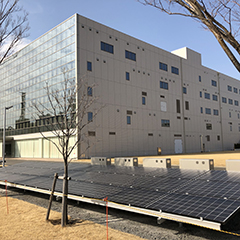Test VPP to combine companies’ peer-to-peer network technology and renewable energy products for improved energy distribution
Kyoto/London, March 12th, 2019. Kyocera and New York-based LO Energy Inc. today announced a joint project to test the feasibility of a blockchain-managed virtual power plant (VPP) utilizing a peer-to-peer1 distributed consensus network. The test started February 28th, 2019 at Kyocera’s Yokohama Nakayama Office in Kanagawa Prefecture, Japan, where a small VPP was installed using the company’s solar photovoltaic (PV) modules and batteries. The energy will be controlled through LO3 Energy’s distributed ledger technology to log and manage energy flow. LO3’s blockchain technology is used for verifying and recording transactions, enabling consumer “sharing” of energy they produce with their own solar panels via a microgrid, which can reduce the burden on the larger energy grid.
Background and Purpose
In Japan, where renewables play a major role in the government’s energy portfolio plans, a dedicated research initiative is under way to create new “smart” energy networks. Kyocera has continually provided solar power generating systems and storage batteries for Japan’s government-led VPP test projects, developing new expertise in remotely controlled distributed power resources. By combining Kyocera’s expertise with LO3 Energy’s blockchain technologies, the companies will evaluate VPPs that promote a low-carbon society without fuels or CO2 emissions.
“Kyocera is committed to developing low-carbon solutions that maximize renewable energy resources,” said Hironao Kudo, Deputy General Manager of Kyocera Corporation’s Corporate R&D Group. “We are excited to be the company in the area of grid management in Japan to collaborate with LO3 Energy, which has consistently proven its blockchain technologies all around the world.” Kyocera entered the renewable energy field in the 1970s with solar photovoltaic (PV) modules and has continued to diversify its business into storage batteries and HEMS solutions.




























